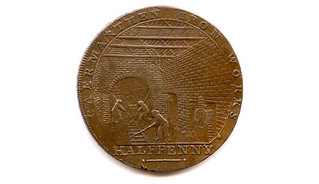
PREV ARTICLE
NEXT ARTICLE
FULL ISSUE
PREV FULL ISSUE
GEORGE SELGIN'S HISTORY OF THE PENNY
E-Sylum reader George Selgin published a nice article on Bloomberg.com about the history of the penny. Thanks for Dick Johnson for passing this along. Here's an excerpt from "When Entrepreneurs Privatized the Penny".
-Editor
They were made of bronze -- copper with a touch of zinc and tin. Though not exactly precious, that metal was at least august enough for decorating brave soldiers and Olympic athletes. But pennies have been on a downward slide ever since. By 1982, they were worth so little that people were melting them for their copper, causing the U.S. Mint to introduce today's version, made of cheap zinc disguised by a thin copper coat. Today even the zinc versions cost almost 2.5 times as much to make as they are worth -- costing taxpayers about $60 million last year. So Congress is considering another switch, to lowly steel. Would it be better to simply give up on the penny, as Canada decided to do in March? The story of the British penny, first minted in the eighth century, offers an instructional case. It, too, came within an inch of dying. But it was saved by a handful of entrepreneurs. The British penny started out as a silver coin. By the start of the 18th century, silver had become so valuable that pennies made from it were quickly melted down. So the Royal Mint quit making pennies except in tiny quantities used for ceremonial purposes. Halfpennies were made of copper, but they attracted enterprising counterfeiters. By 1775, the mint stopped coining copper altogether. The hitch was that its decision came just as the Industrial Revolution was gaining steam. And that revolution called for unprecedented amounts of small change for paying workers' wages and stocking retailers' tills. Unless someone supplied the necessary coins, British economic development would come to a halt. The Royal Mint stuck to its decision. Help came instead from some of the same entrepreneurs responsible for Great Britain's industrial liftoff. Leading the way were Thomas Williams, the owner of what was then the world's biggest copper mine, on the Welsh island of Anglesey, and Matthew Boulton, the owner of the world-famous Soho Manufactory, located just outside of Birmingham.
To read the complete article, see:
When Entrepreneurs Privatized the Penny
(www.bloomberg.com/news/2012-05-08/when-entrepreneurs-privatized The Numismatic Bibliomania Society is a non-profit organization promoting numismatic literature. See our web site at coinbooks.org. To submit items for publication in The E-Sylum, write to the Editor at this address: whomren@gmail.com To subscribe go to: https://my.binhost.com/lists/listinfo/esylum All Rights Reserved. NBS Home Page Contact the NBS webmaster 
|
